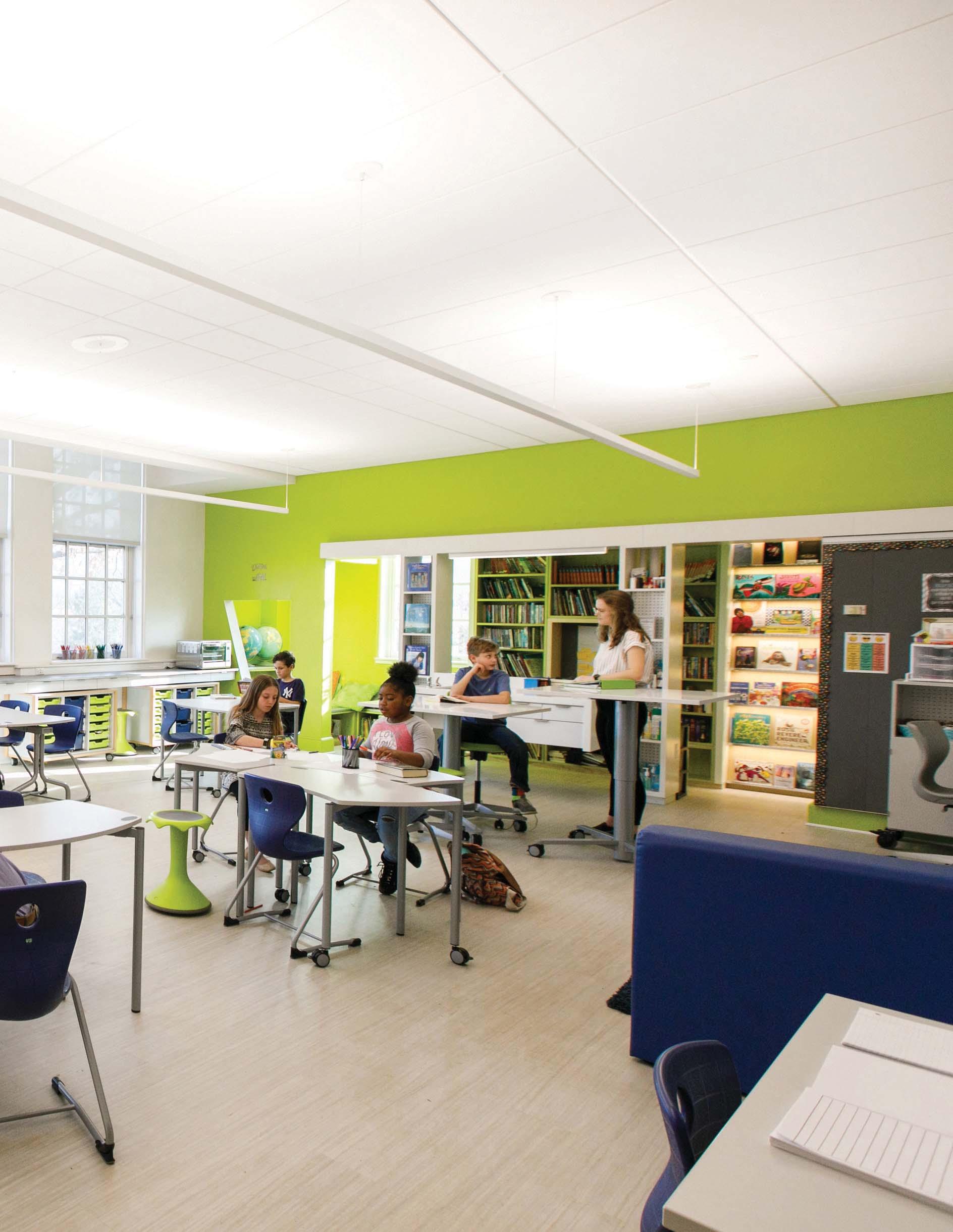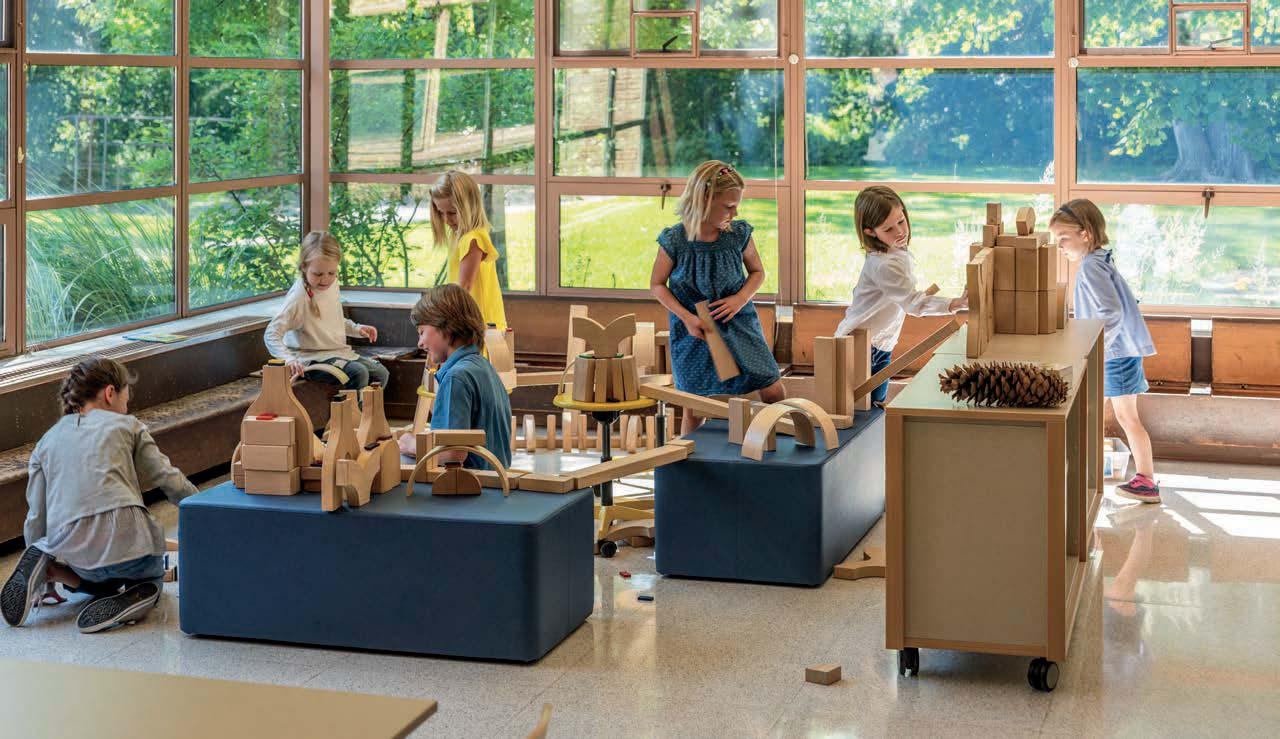
3 minute read
FIVE KEYS TO CREATING A MOVEMENT-FRIENDLY SCHOOL AND CLASSROOM CULTURE
• Make furniture and space decisions based on current findings on humane workplace design and ergonomic best practices.
• Create spaces for flexible configurations.
• Use the entire school for normal daily tasks and activities, pushing beyond classrooms to corners and niches, corridors, and outside areas.
• Implement student-centered learning concepts such as group work, selforganized learning, and process work.
• Create spaces that answer the needs of normal school day rhythms – in a sense accommodating the yin and yang, between excitement and relaxation, hard work and recovery.
References:
Altenburg TM et al. (2015). Bouts and breaks in children‘s sedentary time: currently used operational definitions and recommendations for future research. Prev Med. 77: 1-3. doi:10.1016/j.ypmed.2015.04.019.
American Journal of Preventive Medicine (2016).
Banzer, W., Fuzéki, E. (2011): Körperliche Inaktivität, Alltagsaktivitäten und Gesundheit. In: LIGA.NRW (Hrsg.): Gesundheit durch Bewegung fördern. Empfehlungen für Wissenschaft und Praxis. LIGA.Fokus 12. Düsseldorf.
S. 13–17.
Breithecker D, Mahli M (2008). Untersuchung zur Änderung der Oberkörperdurchblutung während des Sitzens auf Stühlen mit beweglicher Sitzfläche. Haltung und Bewegung, 5-12.
Breithecker D, Mahli M (2014). Wie viel Dynamik gestattet das dynamische Sitzen? Die Säule, 12-16
Burzynska AZ et al. (2014). Physical Activity and Cardiorespiratory Fitness Are Beneficial for White Matter in Low-Fit Older Adults. PLoS ONE 9(9): e107413.
Chastin SF et al. (2012). Relationship between sedentary behavior, physical activity, muscle quality and body composition in healthy older adults.
Age Ageing 41(1): 111–114.
Dunstan DW et. al. (2012). Breaking up prolonged sitting reduces postprandial glucose and insulin responses. Diabetes Care 35(5): 976–983.
Ekblom-Bak E et al. (2010). Are we facing a new paradigm of inactivity physiology? Br J Sports Med 44(12): 834–835.
Haas C et. al. (2011). Komplexe Analyse kinematischer Merkmale des Sitzverhaltens auf unterschiedlichen Sitzmöbeln. Unveröffentlichter Projektbericht. Hochschule Fresenius, Idstein
Haly et al. (2017). A Cluster RCT to reduce worker’s sitting time: Impact on cardiometabolic biomarkers. Med Sci Sports Exerc.
Healy GN et al. (2008a). Breaks in sedentary time: beneficial associations with metabolic risk. Diabetes Care 31(4): 661–666.
Healy GN et al. (2008b). Objectively measured sedentary time, physical activity, and metabolic risk: the Australian Diabetes, Obesity and Lifestyle Study (AusDiab). Diabetes Care 31 (2): 369–371.
Ickes BR et al. (2000). Long-term environmental enrichment leads to regional increases in neurotrophin levels in rat brain. Exp Neurol 164(1): 45–52.
Higgins S et al. (2005). The Impact of School Environments: A Literature Review. https://www.researchgate.net/publication/232607630.
Katzmarzyk PT et al. (2009). Sitting time and mortality from all causes, cardiovascular disease, and cancer. Medicine and Science in Sports and Exercise, 41 (5), 998-1005.
Kempermann G et al. (1997). More hippocampal neurons in adult mice living in an enriched environment. Nature. Apr 3;386(6624):493-5.
Kubesch S (2008). Das bewegte Gehirn. Körperliche Aktivität und exekutive Funktionen. Hofmann, Schorndorf.
Kultusministerium Hessen (2014): Projekt Schnecke. Bildung braucht Gesundheit II. Online: (http://www.bildung-kommt-ins-gleichgewicht.de/ index_htm_files/EvaSchneckeII.pdf).
Levine JA (2002). Non-exercise activity thermogenesis (NEAT). Best Pract Res Clin Endocrinol Metab 16(4): 679–702.
Mahlke W, Schwarte N (1997). Raum für Kinder. Ein Arbeitsbuch zur Raumgestaltung in Kindergärten. 4 Auflage. Weinheim und basel. Ministry of Education, Hessen Germany (2012). Project “Schnecke”. Nike, Inc. (2013). Designed to Move. A Physical Activity Action Agenda. Norretranders T (1997): Spüre die Welt. Die Wissenschaft des Bewusstseins. Reinbek.
Rojas Vega S et al. (2010). Effect of resistance exercise on serum levels of growth factors in humans. Horm Metab Res. 2010 Dec;42(13):982-6. doi: 10.1055/s-0030-1267950. Epub 2010 Nov 4.
Schmid D et. al. (2014) Sedentary behavior increases the risk of certain cancers. Regensburg. Journal of national Cancer Institute.
Schöllhorn W (2015). Die Wirkung dynamischer Haltungskontrolle im Sitzen auf dem Swopper auf die Konzentrationsfähigkeit: Eine EEG-Studie Johannes Gutenberg-Universität Mainz Fachbereich 02 –Sozialwissenschaften, Medien und Sport. Institut für Sportwissenschaft. Unveröffentlichtes Manuskript.
Siddarth P et al. (2018). Sedentary behavior associated with reduced medial temporal lobe thickness in middle-aged and older adults. https:// doi.org/10.1371/journal.pone.0195549.
Tanner CK, Langford A (2003). The Importance of Interior Design Elements as They Relate to Student Outcomes. http://files.eric.ed.gov/ fulltext/ED478177.pdf (Zugriff am 17.08.17).

Tischler B, Atzwanger K (2000). Wasser als Gestaltungselement der Innenarchitektur beeinflusst das menschliche Wohlbefinden. In: Homo, Journal of Comparative Human Biology, 51, S. 133.
Tremblay M et al. (2010). Physiological and health implications of a sedentary lifestyle. In: Appl. Physiol. Nutr. Metab. 35 (6): 725–740.
Wheeler M et al. (2017). Sedentary behavior as a risk factor for cognitive decline? A focus on the influence of glycemic control in brain health. Elsevier Volume 3, Issue 3, 291-480.
Wilmot EG et al. (2012). Sedentary time in adults and the association with diabetes, cardiovascular disease and death: systematic review and meta-analysis. PubMed - indexed for MEDLINE.
Zimmermann M (1993). Das Nervensystem – nachrichtentechnisch gesehen. In R.F. Schmidt / G.










